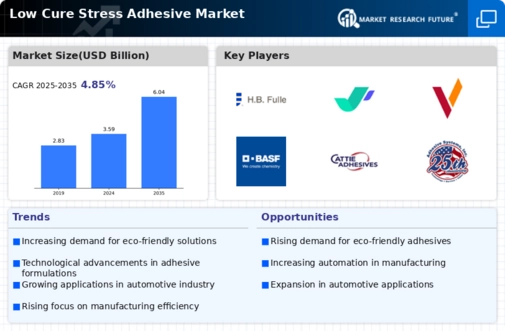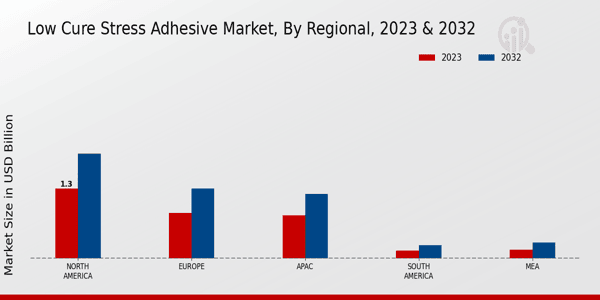Market Growth Projections
The Global Low Cure Stress Adhesive Market Industry is poised for substantial growth, with projections indicating a market value of 3.59 USD Billion in 2024 and an anticipated increase to 6.04 USD Billion by 2035. This growth trajectory suggests a compound annual growth rate (CAGR) of 4.84% from 2025 to 2035. Such figures reflect the adhesive's expanding applications across various industries, including automotive, electronics, and construction. The increasing adoption of low cure stress adhesives is likely to be driven by technological advancements and a growing emphasis on sustainability, positioning the market for a robust future.
Expansion of the Construction Sector
The Global Low Cure Stress Adhesive Market Industry is benefiting from the expansion of the construction sector. As construction projects become more complex, the need for reliable bonding solutions that can withstand various stresses is paramount. Low cure stress adhesives are increasingly utilized in applications such as flooring, roofing, and structural bonding. The growth of the construction industry, driven by urbanization and infrastructure development, is expected to bolster the demand for these adhesives. This trend is indicative of the adhesive's versatility and reliability in meeting the diverse needs of modern construction practices.
Rising Demand in Automotive Applications
The Global Low Cure Stress Adhesive Market Industry experiences a notable surge in demand from the automotive sector. As manufacturers increasingly prioritize lightweight materials to enhance fuel efficiency, low cure stress adhesives are becoming essential for bonding components without compromising structural integrity. In 2024, the market is projected to reach 3.59 USD Billion, with automotive applications accounting for a significant share. This trend is likely to continue as the industry shifts towards electric vehicles, which require advanced adhesive solutions for battery assembly and lightweight structures. The anticipated growth in this sector underscores the adhesive's critical role in modern automotive manufacturing.
Increasing Focus on Sustainable Practices
The Global Low Cure Stress Adhesive Market Industry is increasingly influenced by the global shift towards sustainability. Manufacturers are under pressure to adopt eco-friendly practices, which includes the use of low cure stress adhesives that are less harmful to the environment. These adhesives often contain fewer volatile organic compounds, aligning with regulatory standards aimed at reducing emissions. As industries strive to meet sustainability goals, the demand for such adhesives is expected to rise, further driving market growth. This trend not only supports environmental initiatives but also enhances the market's appeal to consumers who prioritize sustainable products.
Growth in Electronics and Electrical Industries
The Global Low Cure Stress Adhesive Market Industry is significantly influenced by the expansion of the electronics and electrical sectors. With the increasing miniaturization of electronic devices, there is a growing need for adhesives that can bond components without inducing stress. Low cure stress adhesives are particularly suited for applications in smartphones, tablets, and other consumer electronics. As the market evolves, the demand for these adhesives is projected to grow, contributing to the overall market value, which is expected to reach 6.04 USD Billion by 2035. This growth reflects the adhesive's adaptability to the stringent requirements of modern electronic manufacturing.
Technological Advancements in Adhesive Formulations
Technological innovations play a pivotal role in shaping the Global Low Cure Stress Adhesive Market Industry. Ongoing research and development efforts are leading to the formulation of adhesives that offer enhanced performance characteristics, such as improved temperature resistance and faster curing times. These advancements are crucial for industries that require reliable bonding solutions under varying environmental conditions. As manufacturers adopt these new formulations, the market is likely to witness a steady growth rate, with a projected CAGR of 4.84% from 2025 to 2035. This trend indicates a robust future for low cure stress adhesives across diverse applications.






















